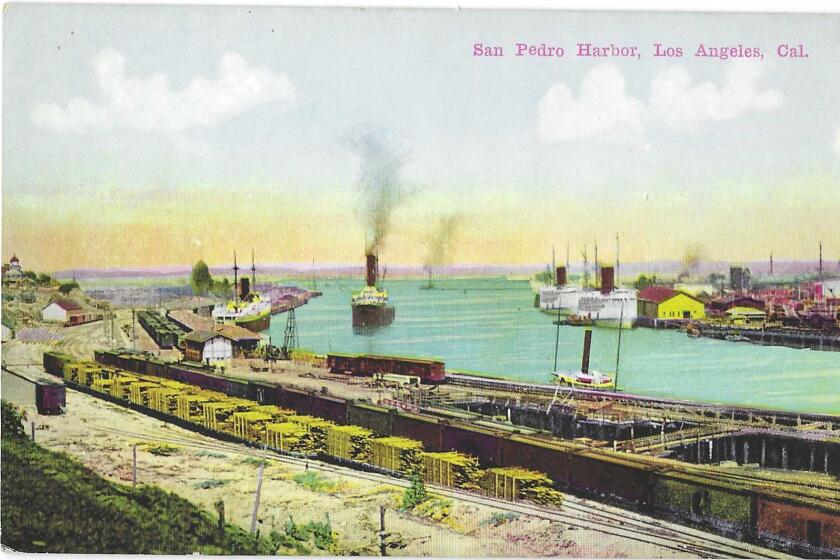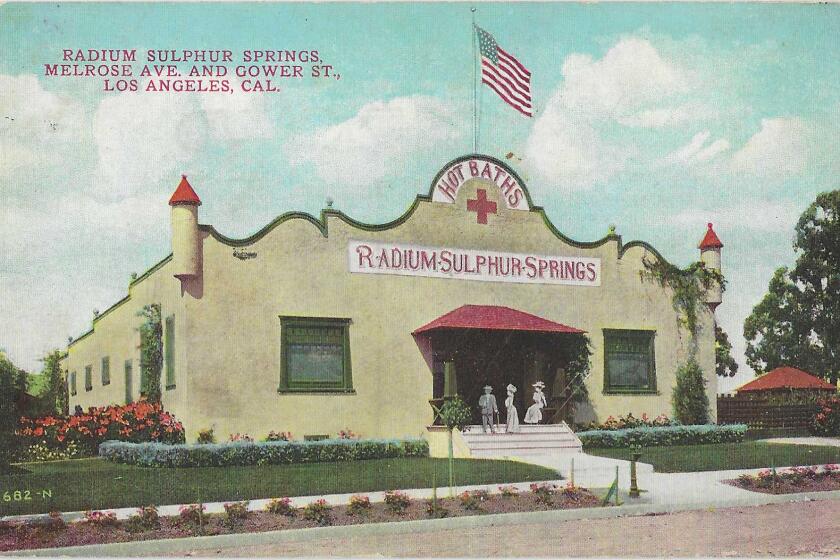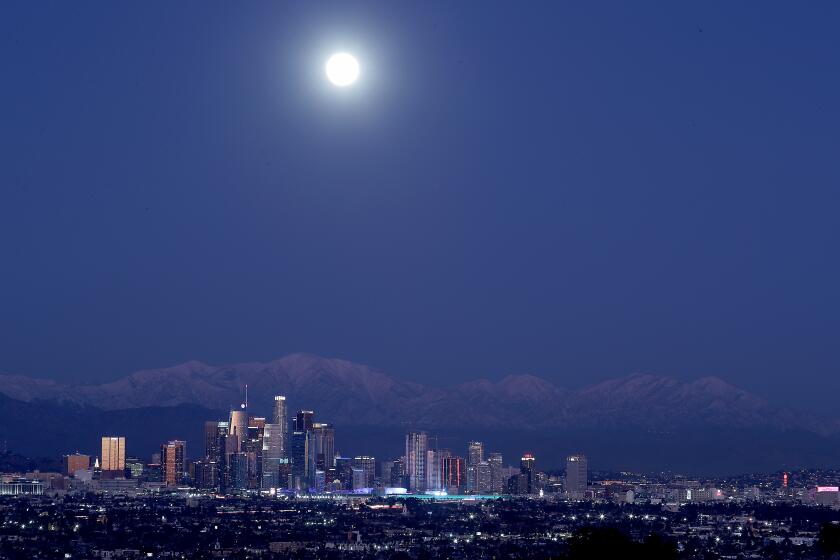Go ahead and rub L.A.’s winter sunshine in people’s faces. We’ve been doing it forever
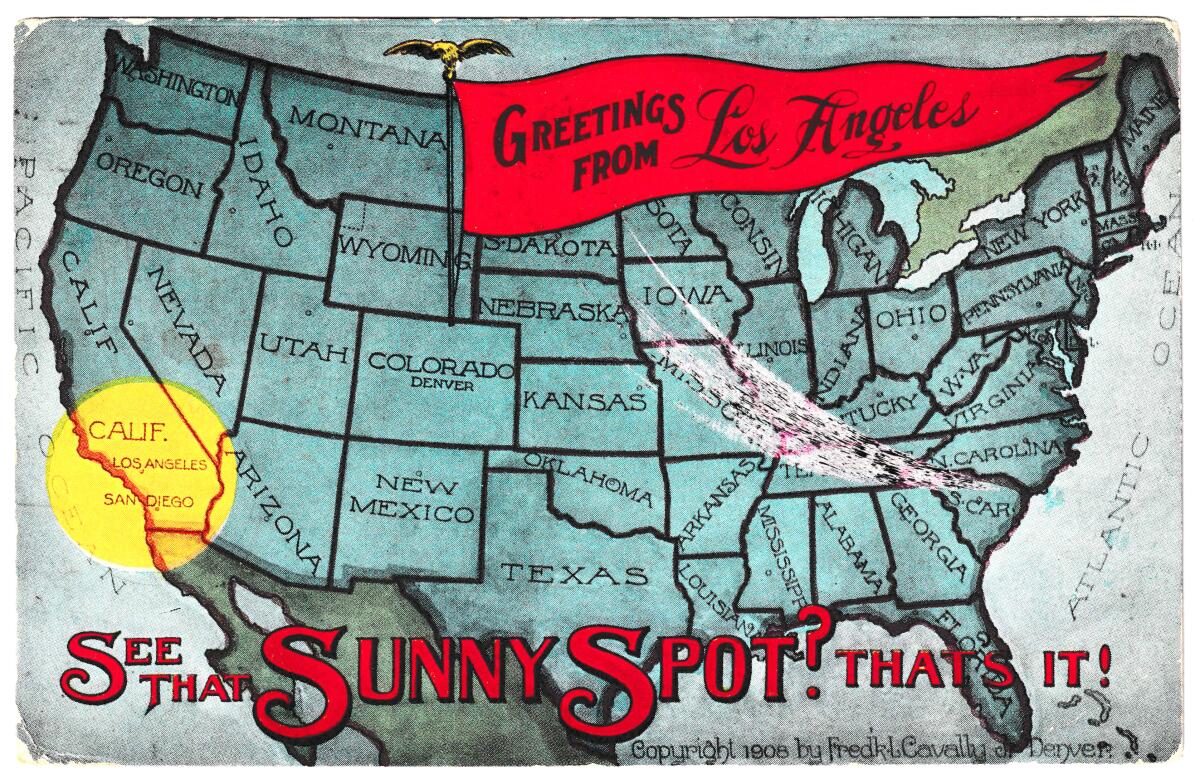
- Share via
How did Los Angeles get so rich and famous?
There’s oil, of course; the plundered soil of L.A. once yielded up more than a third of the country’s oil. And aviation and aerospace; we dreamed up and crafted warplanes, passenger jets and space capsules. And then the movies, late to the starting gate, in time overtook the others in renown.
But L.A. made its first fortune by selling winter — badmouthing other places’ icy, grim months and hyping our own bland, bright, balmy winter.
And we didn’t even bother being nice about it. We straight-up mocked the dopes and losers who chose to stay in the frozen wastes of New England or the Midwest, making snowballs while we plucked oranges from our own backyard trees. As Bill Murray’s character rebuked the demon in “Ghostbusters II,” “If you had Brain One in that huuuge melon on top of your neck, you would be living the sweet life out in Southern California’s beautiful San Fernando Valley.”
Our winter versus their winter is a fight L.A. has picked and won for 150 years, ever since the railroad went transcontinental. Four years after the Golden Spike joined up the east and west rail tracks, a little book by Charles Nordhoff called “California for Health, Pleasure and Residence” was enticing people to California — regular folks and ordinary families, not just the reckless, gold-maddened men of a generation before.
For the early Spanish and Mexican settlers, there was nothing much remarkable about a Southern California that wasn’t unlike their own.
Explaining L.A. With Patt Morrison
Los Angeles is a complex place. In this weekly feature, Patt Morrison is explaining how it works, its history and its culture.
The winter epiphany came when the Yankees did. The underlying justification for their mastery of this bountiful, beautiful semi-tropic place was the conviction that their predecessors — Native American, Spanish, Mexican — were unappreciative and undeserving, unlike the grateful and energetic Yankee. A Bay Area intellectual named Charles Keeler, hired to write a turn-of-the-century promotional pamphlet for the Santa Fe railroad, looked upon the agricultural handiwork as what happens when “a desert occupied by a scanty, unprogressive Mexican population … [is] made by Saxon industry perennial gardens of verdure and bloom.”
In short order, the climate was being promoted as “Mediterranean.” It was not just as a descriptor, which scientists still use today, but as a code word to evoke elegant Englishmen wintering among the antiquities in Italy, not the earthy rusticity of Mexico, of which L.A. had so recently been part.
Climate was what L.A. sold, and really, for years, that’s all it had to sell. Far into the 19th century, L.A. was a scruffy village of dust and mayhem — but just look up, the new Angelenos insisted. Look at our fine mountains, breathe our air, fragrant (eventually) with citrus blossoms. Look at us — in shirtsleeves, in the winter!
When Southern California did get good PR, The Times was almost pathetically eager to promote it. It quoted at length from an October 1893 story in a Liverpool newspaper that praised L.A.’s “picturesqueness and its magnificent climate.”
A seamless railroad brought thousands here without perilous voyages around Cape Horn or slogs across deserts and saber-tooth mountains. Naturally, among the first to climb aboard for California were the ill.
An early and clear-eyed California chronicler did make the Cape Horn trip here. The future author of “Two Years Before the Mast,” Richard Henry Dana Jr. was a Harvard undergrad when a case of measles damaged his eyes. To restore his health, he dropped out at age 19, in 1834, signed on to a California-bound brigantine voyage — as anyone would, right? — and returned to Boston whole in body if not in spirit.
When you think about it, it doesn’t make much sense for 1890s L.A. to put its port all the way in San Pedro. This is the story of how that came to be — and not the competing alternative, Santa Monica.
Tuberculosis, “consumption,” was endemic and fatal. If they had money, the stricken traveled to the Alps or the south of France for relief. Then, miraculously, here was L.A.’s dry, shimmering air, only a few days’ train ride away.
In the chapter called “Southern California for Invalids,” Nordhoff writes of running into a tubercular friend at a hotel in L.A., a friend he had last seen two years before, on the East Coast, at death’s door. Yet here he was, looking hale and hearty: “I shall never be a sound man, of course,” he told the astonished Nordhoff, “but this climate has added 10 years to my life!”
These ailing Angelenos were called “lungers,” for their enfeebled lungs. Camps and sanitariums opened for business, and welcomed trainload upon trainload of them. An 1887 Times story praised Southern California as “a mecca for sick pilgrims,” its climate a miracle treatment for hay fever, asthma, even senility.
The Times was full of ads and testimonials, like this one from 1891 for “Dr. Wong’s Famous Sanitarium” on South Main Street: “Last winter I was a first-class candidate for a consumptive’s grave. … I took Dr. Wong’s medicine and was completely cured in seven weeks’ time.” — R.C. Platt.
Dr. Walter Jarvis Barlow came here from New York in 1895 for his own TB, and ended up heading the county medical association and founding a sanitarium in Echo Park, near Dodger Stadium. It’s still a respiratory hospital today, 120 years after it opened, and it still has his name. The site of the spectacular federal courthouse on the Arroyo Seco in Pasadena was originally a boarding house built in 1882 by Emma Bangs, who had brought her tubercular daughter west. Soon other TB patients discovered the place and moved in; locals called them the “busted lung brigade.”
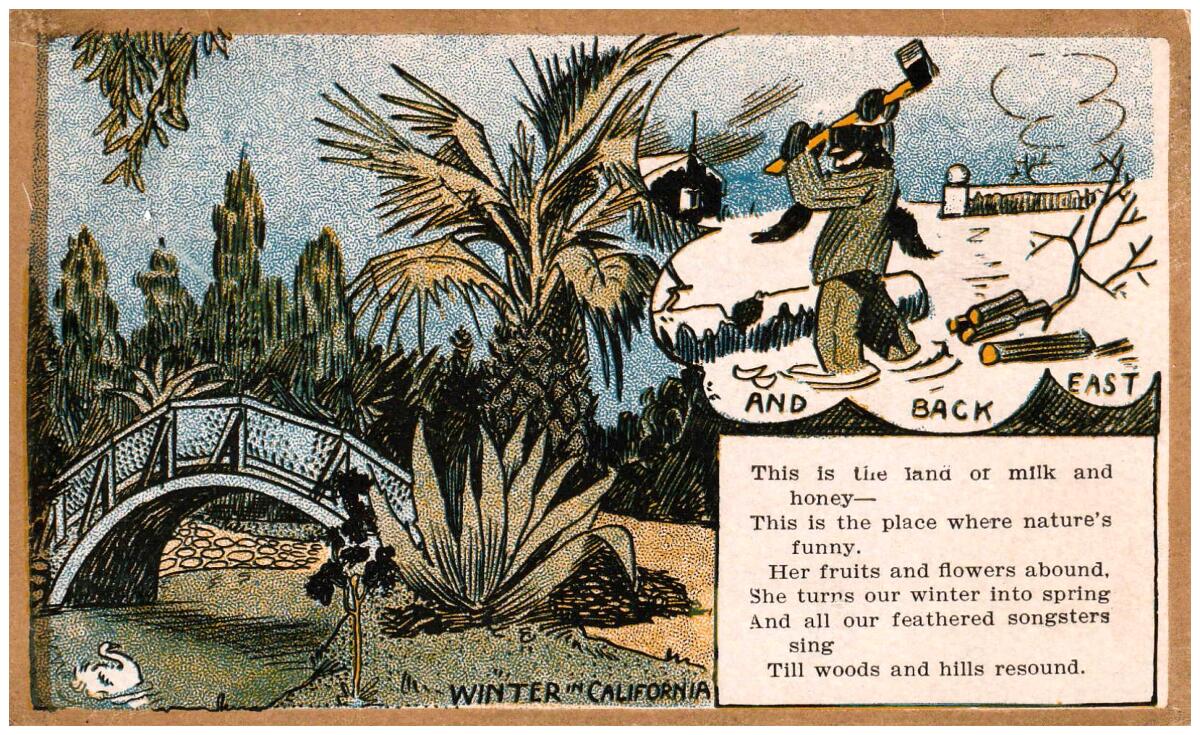
Three of the men most responsible for packaging and selling Southern California’s climate were “lungers” themselves.
Charles Lummis, a Harvard dropout and bosom buddy of Teddy Roosevelt’s, had caught malaria in Ohio. In 1884, he scorned the train and walked to L.A., writing a body of Western observations along the way. His shank’s-mare journey so impressed Times publisher Harrison Gray Otis that Otis hired Lummis as city editor.
Lummis cobbled together a swashbuckling vaquero image for himself and published a magazine called “The Land of Sunshine.” Here’s a bit from the December 1898 issue, a verse by California’s first poet laureate, Ina Coolbrith, who arrived by wagon train when she was 10 years old. “All the long summer hill and valley wide/Crimson with roses, gold with poppies glow/But when the days draw near the Christmas-tide/They clothe themselves with lilies, as with snow.”
Harry Chandler, the son-in-law of the Times publisher and later publisher himself, was a Dartmouth College undergrad when he accepted one of those dopey college-boy dares from a classmate and dived into a vat of frozen starch. (Don’t ask me about starch vats, frozen or thawed; I have no clue.) His lungs began hemorrhaging, he dropped out of college, and joined the sickly train to L.A. He worked out of doors selling fruit and vegetables and became a sturdy, healthy man.
He would use the pages of The Times and its brash January “Mid-Winter” issue — sent tauntingly across Ice Belt America — to peddle the splendors of the place that saved his life and made his fortune. Some stories from the 1957 issue: “You Name It, We Have It,” and “Vacation Time … Any Time at All.”
The geology that cursed Southern California with earthquakes also blessed it with restorative hot springs.
Frank Wiggins was another “lunger,” a man California historian Kevin Starr called “one of the master promoters of the early 20th century.” Over nearly 35 years, he made the L.A. Chamber of Commerce into a relentless, crusading machine of outsized promotion. He sent enticing citrus displays and colorfully grandiose pamphlets to the huge fairs in Chicago and St. Louis, to Paris, even to Guatemala. L.A.’s water wizard, William Mulholland, is said to have joked that the only way to stop L.A. from growing was to do in Frank Wiggins.
These early health seekers were the forebears of our cheerful experiments in sunshine living, the health food markets, the nudist camps, the beachfront muscle culture, and the suntan glow that bespoke not manual labor but a vigorous outdoor life, a look popularized by the early silent film star Douglas Fairbanks.
L.A. clearly overdid the lungers’ welcome. A city populated by coughing multitudes was not a get-up-and-go metropolis, and so it was with some relief to city fathers that their climate ballyhoo also brought a different wave of settlers — farmers, ideally gentlemen farmers.
These were men who sold up the homesteads back east or in the Midwest — many thousands from Iowa alone — and followed the allure of benign sunshine and frost-free harvests to what Times publisher Otis told his friends was “the fattest land I ever was in.”
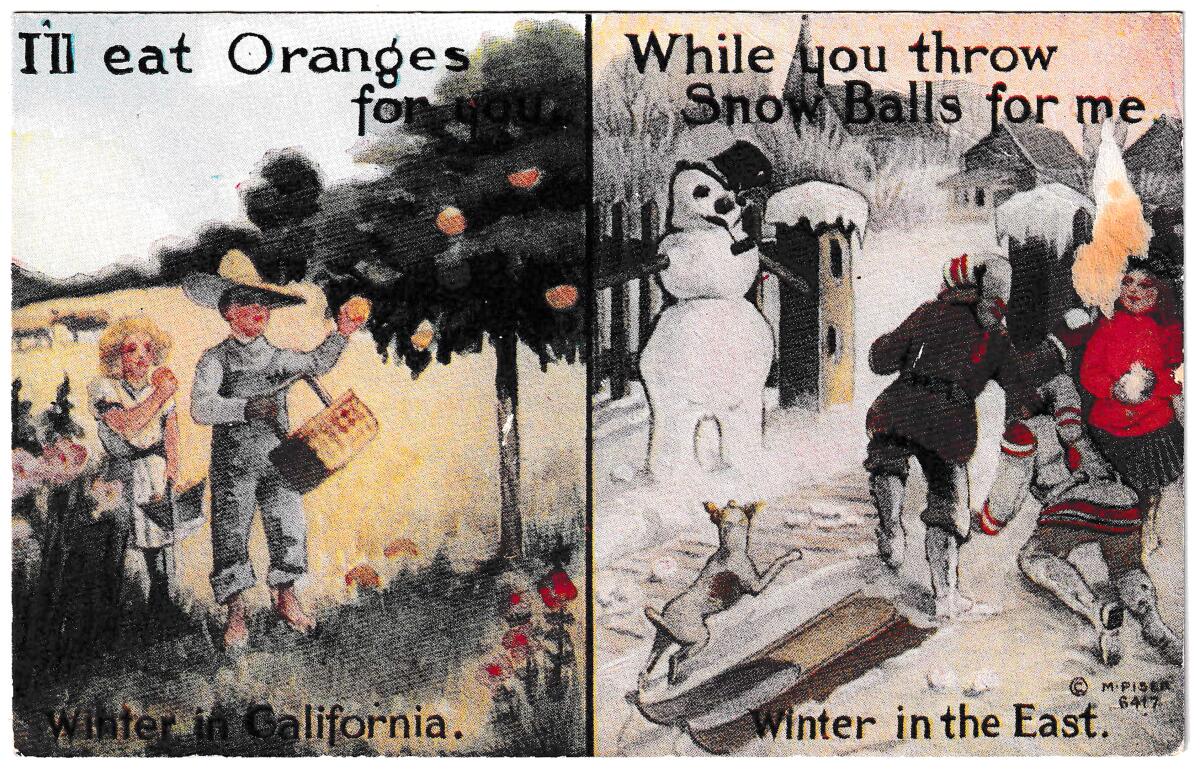
Like Jack’s magic beans, the promoters’ L.A. could grow anything: just add water (this was before the H20 thing became problematic). Climate refugees grew beets and berries and celery and walnuts; wheat and beans and grapes and those exotic “alligator pears,” avocados; and citrus, citrus everywhere — delicious, and so decorative and fragrant in gardens that could make even the meanest little house a floral delight. Someone even tried to grow tea — tea! — and a man named W.D. Curtis bought 20 acres near Alhambra to raise silkworms and the mulberry trees to feed them. (I’m starting to sound like Frank Wiggins.)
L. Frank Baum, the creator of the “Oz” books, bought a house on Cherokee Avenue in Hollywood in 1910, fell under the spell of this kind of “Emerald City” and grew a wondrous flower garden for the delight of his family and his cocker spaniel, Toto.
OK, you’re wondering — but what about the movies?
The movie people arrived last, after the lungers and the farmers, drawn to that serene daylight and a varied landscape that could double for Wyoming or Arabia or a desert island. That’s what Selig Polyscope’s “second unit” was sent here from Chicago to find in 1907, dramatic topography for “The Count of Monte Cristo.” The next year, Selig’s company set up shooting on a “lot” in downtown L.A., before building a studio in what is now Echo Park. More filmmakers followed: D.W. Griffith, Mack Sennett, and in 1913, late to the game, Cecil B. DeMille.
The story goes that he meant to shoot “The Squaw Man” in Flagstaff, but when the train stopped there, in December 1913, it was snowing, or maybe it was raining, or it was sunny but somehow unsuitable — the story changed over time, but by Christmas, DeMille was at work in L.A.
The rich followed the sun, too, as the rich tend to do. Pasadena’s Tournament of Roses was a genteel poke in the eye at the snowbound east, a parade of be-flowered carriages taking the January air along a Millionaires’ Row of mansions built for Gilded Age moguls to “winter” pleasantly.
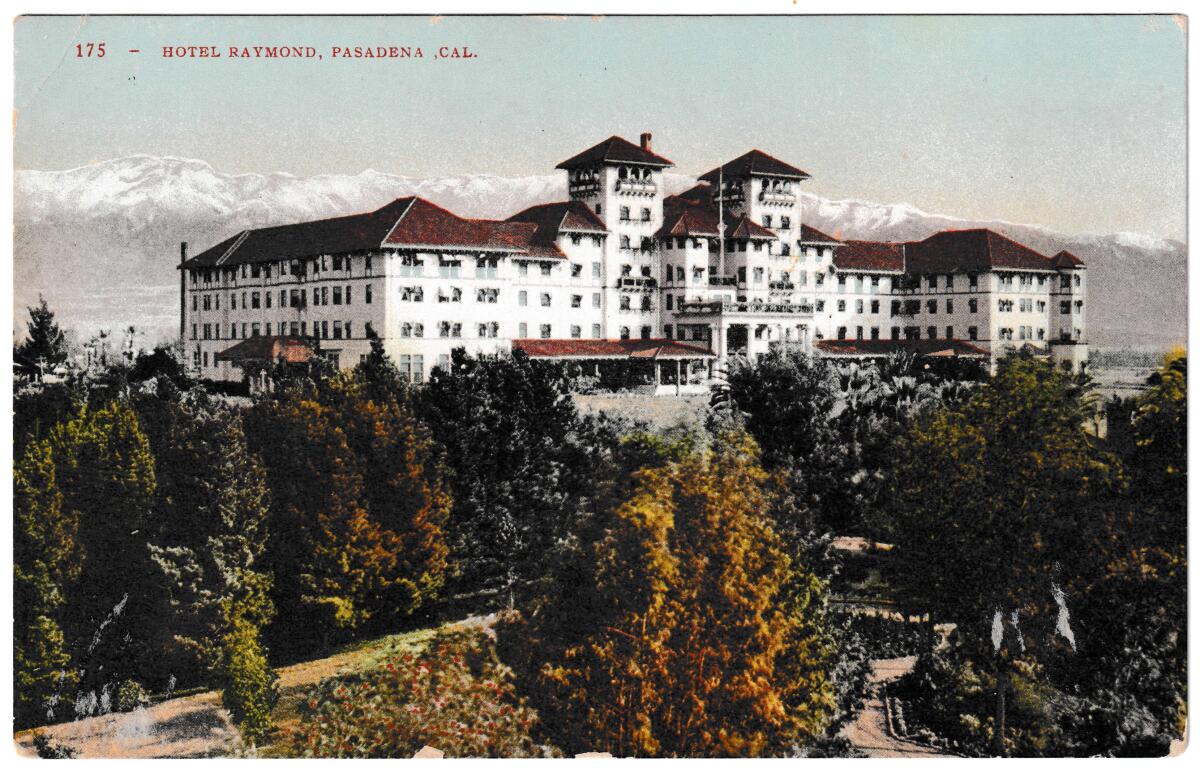
The Raymond hotel — the grandest of the winter resort hotels — towered over South Pasadena, 200 rooms, all wood, and all burned down on Easter Sunday in 1895, and rebuilt in 1901 to welcome rich and renowned “snowbirds” with surnames like Carnegie and Roosevelt.
The PR for Los Angeles in winter was so effective that it took another campaign — the “All-Year Club” — to lure people here for L.A.’s “wonderland of summer.”
When the Austrian screenwriter and actress Salka Viertel arrived here in the 1930s, about to become a celebrated for the films she wrote for her friend Greta Garbo, she was charmed by the funky, low-key beach, and told her husband, Berthold, that she wanted to live in Santa Monica.
“When Berthold mentioned it in the studio, people were horrified,’ she wrote. “Santa Monica! Everybody who lived there became rheumatic, had chronic bronchitis and gout. ‘Then why would all the rich people have houses there?’ I argued. … I was told that those houses were air-conditioned and sound proofed. Their owners had the means to protect themselves from the ocean air and the pounding surf.”
The indoor-izing of L.A.’s climate had begun.
L.A. is a place like no other. You’ve got questions. Patt Morrison probably has answers and can definitely find out.
More to Read
Sign up for Essential California
The most important California stories and recommendations in your inbox every morning.
You may occasionally receive promotional content from the Los Angeles Times.

